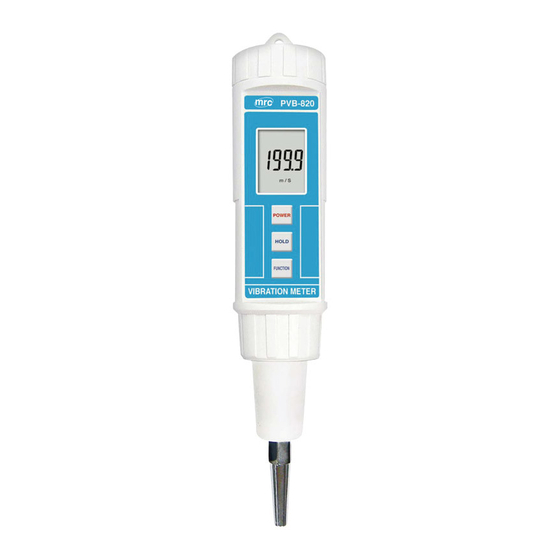Table of Contents
Advertisement
Quick Links
Acceleration, Velocity
RMS measurement, Metric & Imperial unit
PEN VIBRATION METER
Model : PVB-820
OPERATION MANUAL
3, Hagavish st. Israel 58817 Tel: 972 3 5595252, Fax: 972 3 5594529
Your purchase of this PEN
VIBRATION METER marks
a step forward for you into
the
measurement.
this METER is a complex
and delicate instrument, its
durable structure will allow
many
p r o p e r
techniques are developed.
Please read the following
instructions carefully and
always keep this manual
within easy reach.
mrc@mrclab.com
MRC.7.20
field
of
precision
Although
years
of
use
o p e r a t i n g
if
Advertisement
Table of Contents

Summary of Contents for MRC PVB-820
- Page 1 Acceleration, Velocity RMS measurement, Metric & Imperial unit PEN VIBRATION METER Model : PVB-820 Your purchase of this PEN VIBRATION METER marks a step forward for you into field precision measurement. Although this METER is a complex and delicate instrument, its...
-
Page 2: Table Of Contents
TABLE OF CONTENTS 1 FEATURES..............1 2 SPECIFICATIONS............2 2-1 General Specifications..........2 2-2 Electrical Specifications........3 3 FRONT PANEL DESCRIPTION........5 3-1 Display..............5 3-2 Power Button............5 3-3 Hold Button ............5 3-4 Function Button ..........5 3-5 Battery Cover/Compartment.........5 3-6 Vibration Sensor..........5 3-7 Sensing head............5 3-8 Magnetic base............. -
Page 3: Features
1. FEATURES * Applications for industrial vibration monitoring : All industrial machinery vibrates. The level of vibration is a useful guide to machine condition. Poor balance, misalignment & looseness of the structure will cause the vibration level increase, it is a sure sign that the maintenance is needed. -
Page 4: Specifications
2. SPECIFICATIONS 2-1 General Specifications Display LCD, size : 20 mm x 28 mm. Measurement Velocity, Acceleration. * RMS value. Function Acceleration , g, Velocity mm/s, cm/s, inch/s Frequency 10 Hz to 1 KHz * Sensitivity relative during the range the frequency range meet ISO 2954 Refer to table 1, page. -
Page 5: Electrical Specifications
2-2 Electrical Specifications Acceleration ( RMS ) Unit Range 0.5 to 199.9 Resolution Accuracy ± ( 5 % + 2 d ) reading @ 160 Hz, 80 Hz, 23 ± 5 ℃ Calibration ( 160 Hz ) Point @ 1 g = 9.8 Unit Range 0.05 to 20.39 g... - Page 6 Velocity ( RMS ) Unit mm/s Range 0.5 to 199.9 mm/s Resolution 0. 1 mm/s Accuracy ± ( 5 % + 2 d ) reading @ 160 Hz, 80 Hz, 23 ± 5 ℃ Calibration 50 mm/s ( 160 Hz ) Point Unit cm/s...
-
Page 7: Front Panel Description
3. FRONT PANEL & LAYOUT DESCRIPTION Fig. 1 3-1 Display 3-2 Power Button 3-3 Hold Button 3-4 Function Button 3-5 Battery Cover/Compartment 3-6 Vibration Sensor 3-7 Sensing Head 3-8 Magnetic Base... -
Page 8: Measuring Procedure
4. MEASURING PROCEDURE 1)Attaching Meter Body with the Sensing head a. Connect ( Screw ) the " Sensing Head " ( 3-7, Fig. 1 to the bottom of the " Vibration Sensor " ( 3-6, Fig. 1 ). b. Hold the meter's body by hand loosely. Touch the front pin of the "... - Page 9 2)Cooperate with the Magnetic base a. If the measuring surface is a ferrous material, you may consider using the " Magnetic base " ( 3-8, Fig. 1 ) on the " Measurement area ", screw the " Magnetic base " ( 3-8, Fig. 1 ) to the bottom of " Vibration sensor "...
- Page 10 3)Function Selection Select the desired function by pressing the " Function Button " ( 3-4, Fig. 1 ) once the measurement Function will be present in sequence. Measurement Metric unit Imperial unit Acceleration Velocity mm/s, cm/s inch/s The Display will show the indicator : ACC : Acceleration VEL : Velocity mm/s...
-
Page 11: Zero Adjustment Procedure
5. ZERO ADJUSTMENT PROCEDURE 1)Open the " Battery Cover " ( 3-5. Fig. 1 ). Use one finger to press the " Battery holder " to the battery snap can contact the batteries completely. 2)Power on the meter by pressing the " Power Button " ( 3-2, Fig. -
Page 12: Battery Replacement
6. BATTERY REPLACEMENT 1)When the LCD display shows It is necessary to replace the battery. However, some measurements may still be made for several hours after Low Battery Indicator first appears, before the instrument can become less accurate. 2)To replace the battery, rotate and remove the " Battery Cover "... -
Page 13: Classification Ranges
8. CLASSIFICATION RANGES For the valuation of machines and equipment in the ISO 2372 and VDI 2056, four different kinds of machine groups with four classification ranges and their limits for vibration severity ( mm/s ) are determined. The classifications for each machine group are specified as follows : Small machines, especially production electrical motors of up to 15 KW ( Group K ) -
Page 14: Sensitivity Relative Table According
Large machines on heavy foundations ( Group G ) Good 0 to 1.80 mm/s Acceptable 1.81 to 4.50 mm/s Still permissible 4.51 to 11.2 mm/s Dangerous > 11.2 mm/s Largest machines and turbo machines with a special foundations ( Group T ). Good 0 to 2.80 mm/s Acceptable...

















Need help?
Do you have a question about the PVB-820 and is the answer not in the manual?
Questions and answers